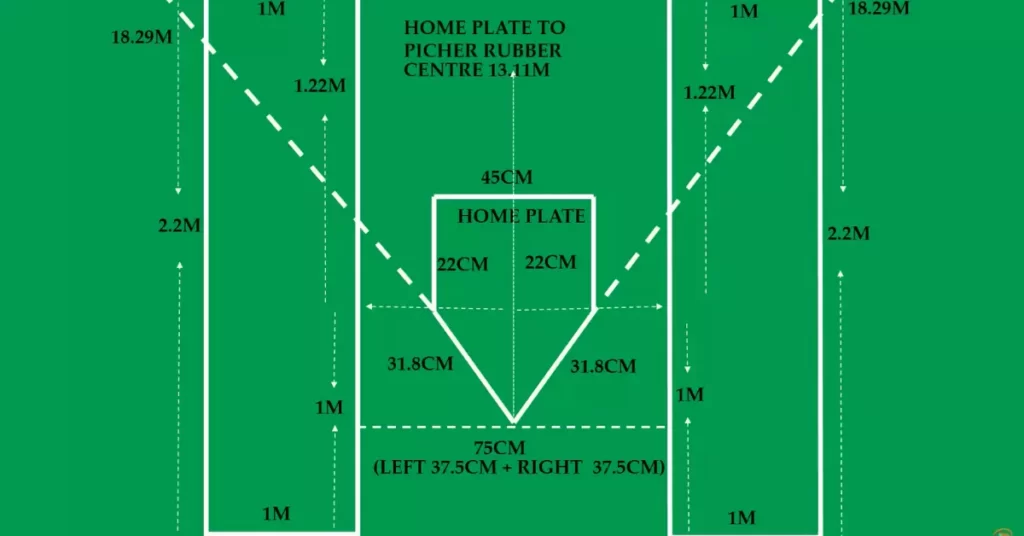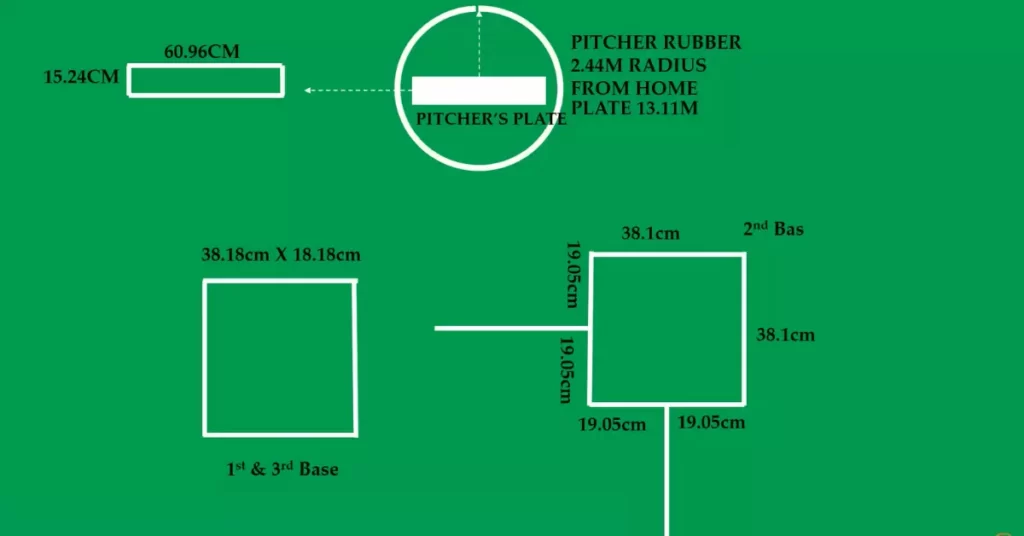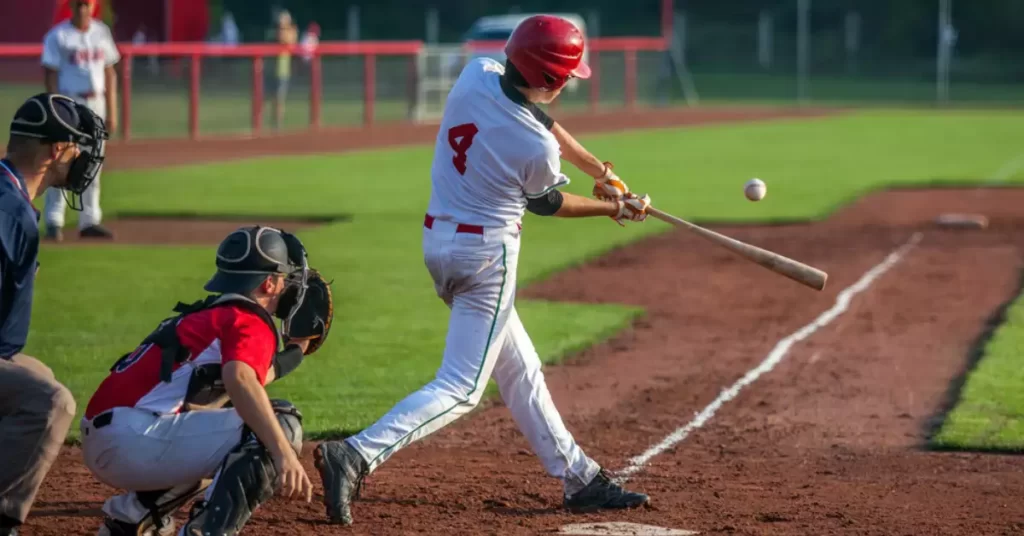The exhilarating world of softball offers both entertainment and competitive opportunities for players and fans alike. As a fast-paced and dynamic sport, understanding the field dimensions is key to fully appreciating its nuances.
A well-defined playing area not only ensures fair gameplay, but also contributes to the overall safety of the athletes.
In a nutshell, a standard softball field comprises a diamond-shaped infield, an outfield, and foul lines. The dimensions vary depending on the type of softball played – fastpitch or slowpitch – and the age group of the players. Key aspects include the distance between bases, the size of the pitcher’s circle, and the depth of the outfield.
Dive deeper into this article as we unravel the specifications of softball field dimensions, and explore how they impact gameplay. Enhance your knowledge and appreciation for this beloved sport, and gain a competitive edge on the field. Let’s get started!
The Importance of Proper Field Dimensions
The Role Of Standards
Softball field dimensions are standardized by organizations such as the International Softball Federation (ISF) and the Amateur Softball Association of America (ASA).
Adhering to these standards ensures that games are played on a level playing field, promoting fairness and consistency across all levels of play.
Moreover, standardized dimensions also facilitate player development and progression from amateur to professional leagues.
Safety Considerations
Proper field dimensions are crucial for ensuring the safety of players and spectators. A well-designed field reduces the risk of injuries due to collisions, falls, or errant throws, while also minimizing the likelihood of damage to nearby property or vehicles.
SWINGRAIL Baseball/Softball Swing Trainer Aid
- THE SIMPLE WAY TO IMPROVE YOUR SWING MECHANICS & BECOME A BETTER HITTER!
- INNOVATIVE TRAINING AID ALLOWS PLAYERS TO “FEEL” HOW TO SWING CORRECTLY; Trains Players to Develop Proper Muscle Memory for "Live" Hitting in Games
- CORRECTS SIX COMMON HITTING MISTAKES; Breakaway Guidestrap Provides Immediate Feedback When the Player Swings Incorrectly
- USED BY MORE THAN 250,000 PLAYERS FROM AGES 9 TO PROFESSIONAL; Winner of Collegiate Baseball’s “Best of Show” Award at the American Baseball Coaches Association convention
- INCLUDES 15 ONLINE INSTRUCTIONAL VIDEOS & TRAINING PROGRAM; “SWINGRAIL Helps me stay inside and take a great path to the ball”, CODY BELLINGER
Softball Field Components and Dimensions
Fastpitch Vs. Slowpitch Softball
Before delving into specific dimensions, it’s essential to understand that there are two primary types of softball: fastpitch and slowpitch. While both share many similarities, their field dimensions differ slightly due to the nature of the game.
Baselines And Bases
The baselines of a softball field are the straight lines connecting the bases.
- Fastpitch softball: 60 feet between bases
- Slowpitch softball: 65 feet between bases
- Bases: 15-inch square bags (except for home plate)
- Home plate: 17-inch pentagonal rubber slab
Infield Dimensions
The infield of a softball field is a square area enclosed by the baselines.
- Fastpitch: 60-foot sides square infield
- Slowpitch: 65-foot sides square infield
The pitcher’s circle, a vital component of the infield, is an 8-foot radius circle centered on the pitching rubber.
- Fastpitch pitching rubber to home plate: 43 feet (women), 46 feet (men)
- Slowpitch pitching rubber to home plate: 50 feet (both genders)
Outfield Dimensions
The outfield is the area beyond the baselines and extends to the outfield fence. Outfield dimensions and Fence heights vary significantly.
- Fastpitch: fences typically 200-275 feet from home plate
- Slowpitch: fences typically 275-325 feet from home plate
- Fence heights: 4-8 feet, depending on the level of play and specific field requirements
Foul Territory
Foul territory is the area outside the baselines, extending from home plate to the outfield fence. While not strictly regulated, sufficient foul territory is crucial for allowing fielders to make plays on foul balls, impacting the game’s overall pace and competitiveness.
| Details of a field | Measurements |
|---|---|
| Each baseline’s length | 60 feet |
| The distance from the first base’s right-field corner to the home plate’s rear | 60 feet. |
| The distance from the back right corner of the first base to the center of the second base | 60 feet |
| The distance from the center of the second base to the far-left corner of the third | 60 feet |
| The distance between the back of the home plate and the front of the pitching rubber | 43 feet |
| Female fastpitch softball proposes a distance from home plate to the outfield | 200 feet (min) |
| Male fastpitch softball proposes a distance from home plate to the outfield | 200 feet (min) |
| Slow female pitch recommends a distance | 250 to 275 feet |
| Slow male pitch suggested distance | 275 to 300 feet |
Special Features and Markings
Batter’s Boxes And Catcher’s Box
The batter’s boxes are two 3-foot by 7-foot rectangles adjacent to home plate, with one box for right-handed batters and another for left-handed batters. The catcher’s box, located directly behind home plate, is a 10-foot by 8.5-foot rectangle.
Coach’s Boxes
Coach’s boxes are designated areas for base coaches, typically measuring 15 feet by 15 feet and located in foul territory along the first and third baselines.
On-Deck Circles
On-deck circles are two 5-foot diameter circles located in foul territory, equidistant from home plate, and adjacent to the first and third baselines. These circles provide a space for the next batter to warm up and prepare for their at-bat.
Running Lanes
Running lanes are 3-foot wide paths parallel to the first baseline, extending from the halfway point between home plate and first base to the back edge of first base. These lanes are designed to provide a safe space for runners to avoid collisions with fielders while running to first base.
Foul Poles
Foul poles are tall, vertical markers placed at the outfield corners where the foul lines intersect the outfield fence. They help determine whether a batted ball is fair or foul by providing a visual reference for umpires.

Additional Softball Field Dimensions
Pitching Circle Diameter
The pitching circle is an 8-foot diameter circle centered on the pitching rubber. This circle defines the area where the pitcher must have both feet when starting the pitching motion.
Home Plate Dimensions
Home plate is a 17-inch pentagonal slab made of rubber. It has two parallel sides, each measuring 8.5 inches, and two 12-inch sides that form a right angle. The plate’s final side is a 17-inch diagonal line that connects the 12-inch sides.
How Far Is The Pitcher’s Mound From Home Plate
In fastpitch softball, the distance from the pitching rubber to home plate is 43 feet for women and 46 feet for men. In slowpitch softball, the distance is 50 feet for both genders.

Softball Pitching Distance
The pitching distance varies depending on the type of softball and the level of play. In fastpitch, the distance is 43 feet for women and 46 feet for men. In slowpitch, it is 50 feet for both genders. For youth softball, fastpitch pitching distances range from 35 to 40 feet, depending on age.
College Softball Field Dimensions
In college softball, field dimensions are typically as follows: 60-foot base distance, 43-foot pitching distance for women’s fastpitch, and an outfield fence distance ranging from 200 to 250 feet.
Zippity Outdoor (2 panel) Vinyl Picket Fence Kit
- FENCE APPLICATION: This fence is designed for semi-permanent residential applications that are not subject to intense wear and tear; not recommended to contain large dogs
- SEMI-PERMANENT: Fence can be easily removed and re-installed
- INSTALLATION: Assembles and installs with relative ease- little to no digging required compared to a normal fence; simply insert included pointed stakes into the ground or use a cordless drill and auger bit in hard ground (see instructions for more details)
- PREMIUM-GRADE VINYL: Made with virtually maintenance-free weather resistant vinyl with a 10 year warranty; won't crack, warp, yellow, splinter, or rot; no painting
- CONTAIN SMALL PETS: Perfect to contain small pets or small children; not recommended for large dogs
Distance From Home Plate To First Base
The distance from home plate to first base is the same as the length of the baselines. In fastpitch softball, this distance is 60 feet, while in slowpitch softball, it is 65 feet.
Distance From Home Plate To Second Base
To find the distance from home plate to second base, measure along the diagonal line that connects the two points. In fastpitch softball, this distance is approximately 84.9 feet (60 feet x √2), while in slowpitch softball, it is approximately 91.9 feet (65 feet x √2).
Distance Between 1st And 2nd Base
The distance between first and second base is the same as the distance from home plate to first or third base. In fastpitch softball, this distance is 60 feet, and in slowpitch softball, it is 65 feet.
Girls Softball Pitching Distance
For youth fastpitch softball, the pitching distance varies by age group. For players 10 and under, the distance is typically 35 feet. For ages 11-12, the distance is usually 40 feet.

NCAA Softball Field Dimensions
NCAA softball field dimensions are generally the same as college softball field dimensions, with 60-foot base paths, a 43-foot pitching distance for women’s fastpitch, and outfield fence distances ranging from 200 to 250 feet.
Maintaining a Softball Field
Proper maintenance of a softball field is essential to ensure player safety, optimal playing conditions, and field longevity.
Regular maintenance tasks include dragging the infield to keep the surface smooth and even, watering the field to maintain appropriate moisture levels, and mowing the grass in the outfield.
FAQs
Are There Different Dimensions For Youth Softball Fields?
Yes, youth softball fields typically have shorter base paths and pitching distances. In fastpitch softball, base distances for younger players range from 50 to 60 feet, while pitching distances range from 35 to 40 feet.
Can A Baseball Field Be Used For Softball?
While it is possible to play softball on a baseball field, the dimensions are not ideal, and certain modifications may be required.
The base paths and pitching distances will need to be adjusted, and temporary lines may need to be drawn to indicate the correct locations for the batter’s boxes, catcher’s box, and coach’s boxes.
How Do I Measure The Distance From Home Plate To The Pitching Rubber?
To measure the distance from home plate to the pitching rubber, use a measuring tape and measure along the straight line that connects the apex of home plate to the center of the pitching rubber.
The distance should be 43 feet for women’s fastpitch, 46 feet for men’s fastpitch, and 50 feet for slowpitch softball.
Final Thoughts
Understanding the dimensions of a softball field is vital for ensuring a fair, consistent, and safe playing environment.
By adhering to standardized dimensions set by governing bodies like the ISF and ASA, players can develop their skills and progress through the ranks, while spectators can enjoy a thrilling and competitive game.
Ultimately, familiarizing oneself with these dimensions helps players, coaches, and fans appreciate the intricacies of the sport. Knowledge of these parameters contributes to better strategic planning and a deeper understanding of the game.


